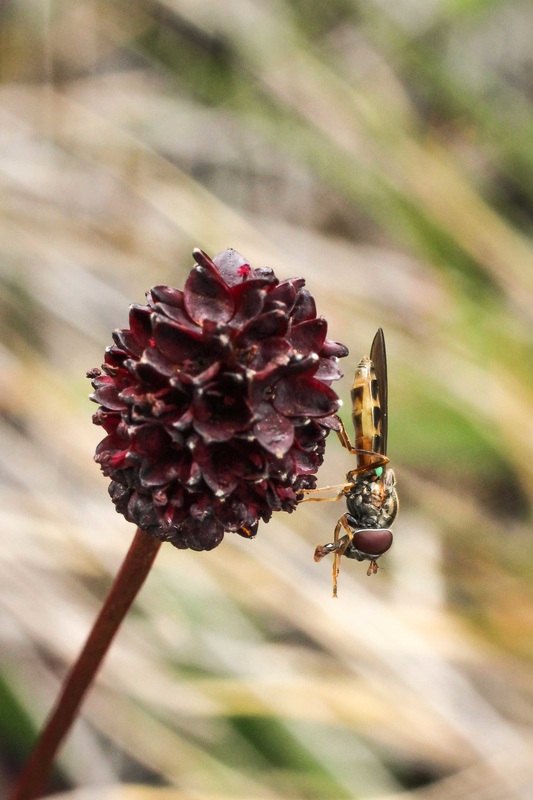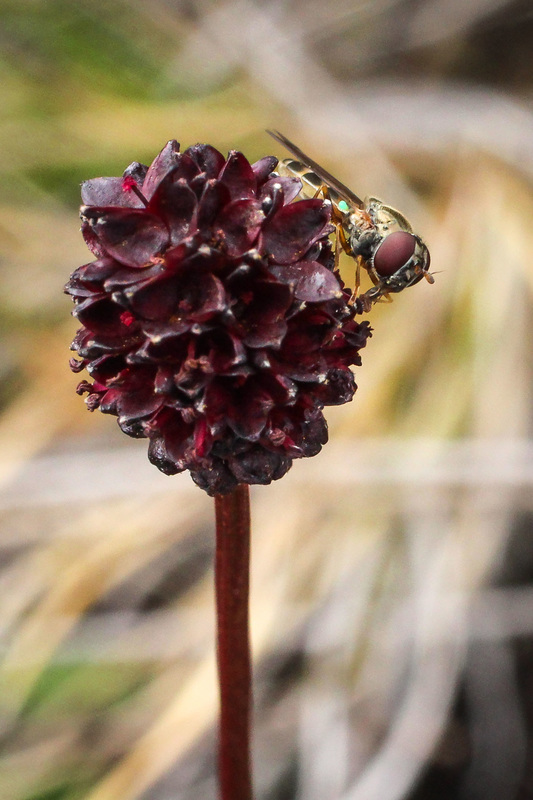Melanostoma mellinum
|
Melastoma mellinum on great burnet (Sanguisorba officinalis) flowers. Note the green halteres. Photos by Nancy Shackelford.
|
Identification
Melanostoma mellinum is a flower fly (Family Syrphidae). Most individuals have a narrow, black abdomen bearing pairs of yellow spots, though the species can be quite variable in appearance and sometimes these spots are reduced or absent. The normally pale halteres (balancing organs attached to the thorax, near the wing bases) turn bright blueish-green in females about to lay eggs.
Habitat & Range
This common fly is associated with vegetation dominated by grasses, and frequently visits flowers. It is found in throughout North America, as well as much of the rest of the northern hemisphere (a holarctic species).
Similar Species
This is the only North American species found in the Melanostoma genus. Some Platycheirus species are similar in appearance; Melanostoma mellinum can be differentiated by a well-defined depression in its metasternum, found on the ventral side. Click here for a photo of this feature.
iNaturalist
https://www.inaturalist.org/taxa/324344-Melanostoma-mellinum
Melanostoma mellinum is a flower fly (Family Syrphidae). Most individuals have a narrow, black abdomen bearing pairs of yellow spots, though the species can be quite variable in appearance and sometimes these spots are reduced or absent. The normally pale halteres (balancing organs attached to the thorax, near the wing bases) turn bright blueish-green in females about to lay eggs.
Habitat & Range
This common fly is associated with vegetation dominated by grasses, and frequently visits flowers. It is found in throughout North America, as well as much of the rest of the northern hemisphere (a holarctic species).
Similar Species
This is the only North American species found in the Melanostoma genus. Some Platycheirus species are similar in appearance; Melanostoma mellinum can be differentiated by a well-defined depression in its metasternum, found on the ventral side. Click here for a photo of this feature.
iNaturalist
https://www.inaturalist.org/taxa/324344-Melanostoma-mellinum
References
Genus Melanostoma. BugGuide. Accessed 29/09/2015.
Miranda, G. F. G. et al. (2013). Key to the Genera of Nearctic Syrphidae. Canadian Journal of Arthropod Identification No. 23, 23 August, 2013. Accessed 29/09/2015.
Vockeroth, J. R. (1992). The Flower Flies of the Subfamily Syrphinae of Canada, Alaska, and Greenland: Diptera, Syrphidae. The Insects and arachnids of Canada. Centre for Land and Biological Resources Research. Ottawa, ON: Research Branch Agriculture Canada. P. 155-158.
Authors and editors
Kelly Fretwell and Brian Starzomski (2015).
Genus Melanostoma. BugGuide. Accessed 29/09/2015.
Miranda, G. F. G. et al. (2013). Key to the Genera of Nearctic Syrphidae. Canadian Journal of Arthropod Identification No. 23, 23 August, 2013. Accessed 29/09/2015.
Vockeroth, J. R. (1992). The Flower Flies of the Subfamily Syrphinae of Canada, Alaska, and Greenland: Diptera, Syrphidae. The Insects and arachnids of Canada. Centre for Land and Biological Resources Research. Ottawa, ON: Research Branch Agriculture Canada. P. 155-158.
Authors and editors
Kelly Fretwell and Brian Starzomski (2015).






